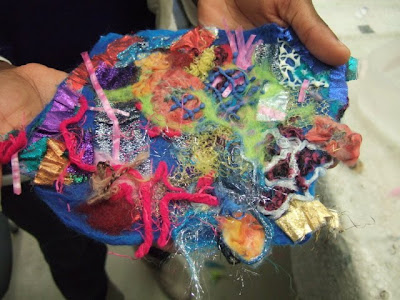This is what Lin Osborne from the gallery said,
"Thankyou to you for making the workshop such a success. It was wonderful to see even very small children really engaged and getting wonderful results that could easily have been produced by adults. I know I was thrilled with the piece I made! During the day we had both quantity and quality and that isn't always possible during drop-in sessions.”
I called the sessions Fantastic Textural Felting and they were designed to tie in with the Taking Time: Craft & the Slow Revolution exhibition.
I happen to love textures and do draw on various tactile memories from my childhood when making my own work www.frillipmoolog.co.uk. I also really enjoy the many textures that can be achieved in the feltmaking process.

One of the most exciting things about teaching feltmaking is seeing the delight on people’s faces when they realise that they have made something that only minutes before they would never have believed that they could do.
This is especially noticeable in adults, especially adults who have brought children along to a session, and really didn’t expect to be able to have a go themselves.
So many people have left school believing that they aren’t artistic, can’t make things and have no imagination. So I am absolutely delighted when I am able to dispel these damaging myths!
 Some artists don’t enjoy workshops as we are often are asked to put together a session where the time allowed is shorter than ideal. I was very lucky at Birmingham Museum & Art Gallery last week.
Some artists don’t enjoy workshops as we are often are asked to put together a session where the time allowed is shorter than ideal. I was very lucky at Birmingham Museum & Art Gallery last week.Although billed as a drop-in workshop we ended up having groups of up to 12 people at a time. Each session was about 1 hour long.
This was fantastic as I was able to:
- introduce felting,
- explain how to lay out the merino wool fibres
- and explain a bit about the process of felting
- and the participants had time to make their own unique pieces.
Making felt is ideal for the kinesthetic learner. It is not an exact science. But simply by making a piece, participants can experience and feel the process as it happens.

At the beginning of the session I explained that we were linking into the exhibition Taking Time: Craft & the Slow Revolution.
I joked with the children in the session that we were actually going to be working fast as opposed to slow and that although none of them had made felt before we were going to start straight away with some Advanced Feltmaking.
I said that it was like going straight into year 6 at school!
So what was advanced and how did we link into the concept of Slow?
We talked about recycling and using fabrics that had already had a life: a chiffon blouse, an old piece of sequined sari fabric, old turban cloth, remnants of fabrics from dressmaking projects and even plasterer’s scrim.
We managed to recycle some pre-felt from previous projects. Pre-felt is partially made felt where the wool fibres have not completely felted and will still “accept” new added wool fibres.
We also used some interesting textiles, which although not recycled, were very unusual to incorporate into the felting process. Rubber fabric (the kind laid under rugs to stop them from moving) and also knitted metal and plastic pan scourers were cut up and incorporated with the lovely soft merino wool fibres.
I wished that I had mentioned that waiting for the sheep to grow its fleece could be seen as a slow part of the process.
It was impossible to cover all the possible aspects of the Taking Time: Craft & the Slow Revolution.
Things like:
- Taking Time to think about the aesthetics of what you are making.
- Thinking about the materials that you want to use in it
- Sourcing these materials
- Using sustainable materials from renewable resources
Even though the sessions were only an hour long the results were spectacular and people from 3 year olds to grandparents were all surprised and delighted with their results.
I do believe that they will definitely reflect over their experiences in my AllSensesArt Textural Felting Workshop and that their unique creations will give them pleasure for a LONG time to come.
I have said it before but I know that so many of these hand-made pieces of art made in snatched creative opportunities (including drop-in workshops) are treasured for YEARS to come.

Excerpts from the exhibition text.
……..The exhibition’s main theme is time and making. Although making takes time it is not necessarily always done at a slow pace………… A consideration of time in the exhibition may go further than first impressions suggest and the pieces on display might ask you to slow down and rethink……….
……..David Gates’ pieces also demand a second look. The furniture at first seems familiar: there are elements we recognize and yet they are different. Consequently we are encouraged to look again and consider where they might belong and why, by slowing down and considering the meaning and life of an object that we so often take for granted………
………Makers may often have a very intense knowledge of the materials that they use. Sonya Clarke makes work which encourages us to ask why it was made. Sonya’s interest in beads goes beyond making with them. She is interested for example in their significance in ancient history and their continued use and relevance in today’s society……..
There is also a blog linked to the exhibition. Look here for artist interviews, curators thoughts and details of outreach activities.
The exhibition runs at Birmingham Museum & Art Gallery until 4th January 2010.




